Staying healthy is important for everyone, with that in mind we thought we’d explore the topic of autism and exercise.
The majority of this article will be aimed at autistic children but there may be some tips which help adults also.
Why exercise may be difficult for those with autism
There are many aspects of day to day life which may be tough for autistic kids.
One area that parents often find challenging is encouraging their autistic child to engage in physical activity.
Here are some reasons why this may be the case;
Social challenges
Many autistic children struggle with social interactions. The structured and rule-bound nature of organised sports as a form of exercise can be intimidating.
The fear of making mistakes or misunderstanding the rules can sadly deter them from participating in group activities.
Difficulty with transitions
Autistic children often find comfort in routine and predictability. Transitioning from one activity to another can be challenging for them.
This ends up making it hard to engage in physical activities that require a change in routine.

Fixed interests
Autistic children (and adults) can have intense interests in certain topics or activities. This could include things like computer games or even trains.
With these intense focuses in mind it may be the case that they child simply doesn’t want to engage in any other activities.
Communication
Struggles with communication are one of the most common impacts of autism.
If this is relevant to your child then it is likely that you would struggle to explain the benefits of exercise.
In addition, similar to the social struggles, if there are communication blockers then explaining rules of games can be tricky.
Sensory factors
Autistic children often experience heightened sensitivities to sensory stimuli.
This heightened sensitivity can make exercise, with its loud noises, bright lights, and unfamiliar textures, feel overwhelming.
Even the feeling of running can be uncomfortable to some.
This can lead to a natural resistance towards physical activities.
What parents can do
Firstly parents should try and establish what the blockers are relating to their specific child. It may be any of the above or something completely different.
Once armed with that then consider trying any of the following;
Experiment with different activities
Not all physical activities have to be traditional sports. Experiment with various activities like swimming, yoga, or martial arts to find something your child enjoys.
The focus should be on fun and engagement rather than competition.
On the subject of yoga there is an excellent YouTube channel devoted to kids yoga. The presenter makes it fun and engaging so worth giving a try.
Prepare a schedule
As mentioned above, predicability is important to a lot of autistic children.
Help your child manage transitions by creating a visual schedule for exercise time. This schedule can provide that desired predictability and reduce anxiety around shifting from one activity to another.
Lead by example
Children often learn by observing their parents.
Try to participate in physical activities together as a family to show your child that exercise is a normal and enjoyable part of life.
This could be something as simple as walking to the shops instead of driving if that is an option.
Another option would be to play games with your children outside. This could involving kicking a football around or even playing tag together.
Make exercise fun
Exercise doesn’t have to be a rigid and structured sport. Try to find ways to get your child moving which link into their desires.
Something like a bubble machine can be a fun way of getting a child active. You can get it going and then challenge your child to pop as many bubbles as they can.
Another classic for autistic children would be getting an indoor or outdoor trampoline.
Bouncing can often provide them with positive feedback and also is guaranteed exercise.
Find SEN friendly clubs
The world is much more accepting and accommodating to children with special needs than in the past.
Have a look online for clubs and entertainment venues which cater to autistic children.
These may be such venues as soft plays or even sports clubs.
Various adaptations are made to help kids with autism at such venues so they are worth considering.
Summary – Autism and exercise
Supporting an autistic child in exercise can be a rewarding journey, but it requires patience, understanding, and adaptability.
By creating and exploring different activities plus setting achievable goals, parents can help their child build a positive relationship with physical activity.
Remember that every small step forward is a significant achievement.
Your support and encouragement can make a world of difference in your child’s physical and emotional well-being.


Getting your child a trampoline is a good way to get them burning calories!
I second this.
Best money we ever spent 🙂